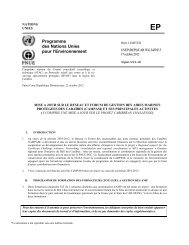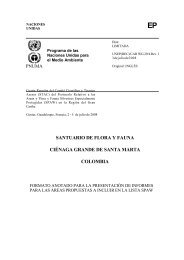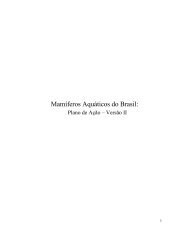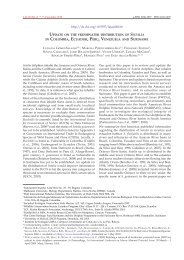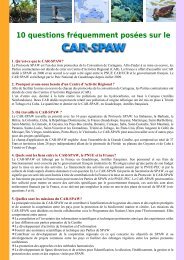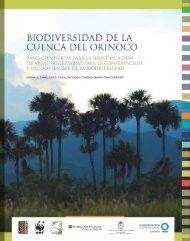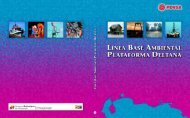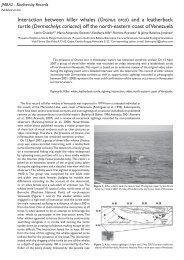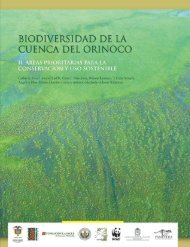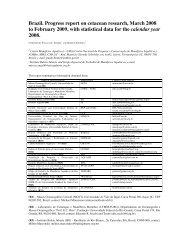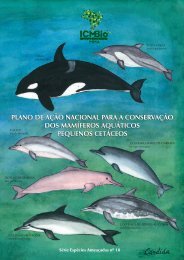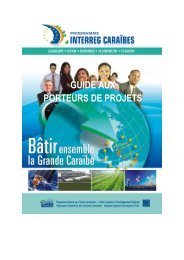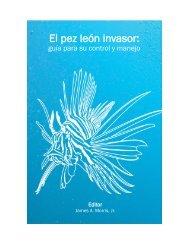Daniel M. Palacios et al. 2012. Cetacean distribution and relative ...
Daniel M. Palacios et al. 2012. Cetacean distribution and relative ...
Daniel M. Palacios et al. 2012. Cetacean distribution and relative ...
- No tags were found...
You also want an ePaper? Increase the reach of your titles
YUMPU automatically turns print PDFs into web optimized ePapers that Google loves.
52 PALACIOS <strong>et</strong> <strong>al</strong>.: CETACEAN DISTRIBUTION AND ABUNDANCE IN COLOMBIAFig. 4. Distribution maps in Colombia’s Pacific EEZ based on sightings from <strong>al</strong>l sources combined (1986–2008) for: (a) pantropic<strong>al</strong> spotted dolphin (Stenellaattenuata) <strong>and</strong> spinner dolphin (Stenella longirostris); (b) striped dolphin (Stenella coeruleo<strong>al</strong>ba); (c) common dolphin (Delphinus delphis) <strong>and</strong> roughtootheddolphin (Steno bredanensis) <strong>and</strong> (d) common bottlenose dolphin (Tursiops truncatus) <strong>and</strong> Risso’s dolphin (Grampus griseus). The number ofsightings for each species is indicated. For clarity, only the bathym<strong>et</strong>ric contours corresponding to the 100m (black) <strong>and</strong> 2,000m (gray) isobaths are shown(source as in Fig. 1).with Panamá (Fig. 5b). Short-finned pilot wh<strong>al</strong>e rankedencounter rate was low (Table 3). Average group size was 16<strong>and</strong> the range was 1–80 (Table 4). The existing densityestimate for this species in Colombia’s EEZ (3.5 anim<strong>al</strong>s per1,000km 2 ; Table 2) is substanti<strong>al</strong>ly lower than that reportedfor Panamá (15.2 anim<strong>al</strong>s per 1,000km 2 ) or Ecuador (13.1anim<strong>al</strong>s per 1,000km 2 ) (Gerrod<strong>et</strong>te <strong>and</strong> <strong>P<strong>al</strong>acios</strong>, 1996).Killer wh<strong>al</strong>e (Orcinus orca)The few sightings of this species were scattered in theoffshore region south of 4°N (Fig. 5b). Killer wh<strong>al</strong>e rankedencounter rate was low (Table 3). Average group size was 5<strong>and</strong> the range was 3–8 (Table 4).Sperm wh<strong>al</strong>e (Phys<strong>et</strong>er macroceph<strong>al</strong>us)Sperm wh<strong>al</strong>e was distributed primarily in the offshore region,including over the M<strong>al</strong>pelo Ridge (Fig. 5c). Rankedencounter rate for this species was intermediate (Table 3).Average group size was 10 <strong>and</strong> the range was 1–34 (Table 4).It is worth noting that despite <strong>relative</strong>ly continuous coverageb<strong>et</strong>ween 1986 <strong>and</strong> 2008, <strong>al</strong>l but two sightings were made priorto 1998, suggesting that sperm wh<strong>al</strong>e has shifted its<strong>distribution</strong> in recent years <strong>and</strong> that it is no longer present inthe Colombian EEZ in the same numbers as in the early yearsof sampling. The home range of the sperm wh<strong>al</strong>e in theeastern tropic<strong>al</strong> Pacific spans ~2,000km (Whitehead <strong>et</strong> <strong>al</strong>.,2008), <strong>and</strong> hence it is possible that the observed trend is, atleast in part, a reflection of the species’ multi-yeardisplacements throughout the region. The existing spermwh<strong>al</strong>e density estimate in Colombia (3.8 anim<strong>al</strong>s per1,000km 2 ; Table 2) is based on data for the period 1986–1993<strong>and</strong> is somewhat lower than that reported for Panamá (5.3anim<strong>al</strong>s per 1,000km 2 ) or Ecuador (5.4 anim<strong>al</strong>s per 1,000km 2 )for the same period (Gerrod<strong>et</strong>te <strong>and</strong> <strong>P<strong>al</strong>acios</strong>, 1996).Dwarf sperm wh<strong>al</strong>e (Kogia sima)There were few sightings of dwarf sperm wh<strong>al</strong>e, which werescattered over the slope <strong>and</strong> in the offshore region, <strong>al</strong>thoughone sighting was made near Cabo Marzo, in the northeastcorner of the EEZ (Fig. 5c). This species had a low rankedencounter rate (Table 3) <strong>and</strong> was only sighted during SWFSCsurveys. Average group size was 2 <strong>and</strong> the range was 1–3(Table 4).Mesoplodont wh<strong>al</strong>es (Mesoplodon spp.)Mesoplodont wh<strong>al</strong>es were well distributed in the offshoreregion south of 5°N, including over the M<strong>al</strong>pelo Ridge (Fig.5d). Two sightings <strong>al</strong>so were made near Cabo Marzo, in the



